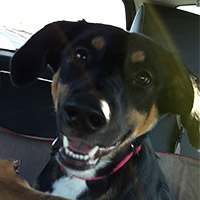I am successfully walking Ellie at 8 months without a harness or a gentle lead by doing a few key things. The first is that I basically just focus on her. When I work with Ellie I get intensely focused and basically ignore other people and dogs. Sometimes I imagine it must seem rude because I don’t say hi and I barely interact with them (even if they’re interacting with me) because Ellie gets my attention. Without being distracted, I can notice and correct behavior much more easily than worrying about being polite to a stranger I will most likely never see again. The second thing is that I heavily focus on eye contact for our walks and spend the vast majority of time looking down at her waiting for the next successful glance. When it happens I say, “Ellie 1 good,” which indicates I want her to look at me when I say Ellie, I count 1 which indicates where she’s at the in the process towards receiving a treat, and “good” so she knows I am happy with her. At the count of 3 I take a treat from the pouch so she know she’s making progress and then give it to her at 5. Eventually I will up this to 5 engaging the treat and 10 giving it to her. When I initially started this process she received a treat at every glance. I also had variations like only giving treats when I said, “Ellie,” instead of counting when she looks at me. I also tried doing it based on the general distance we traveled like counting sidewalk squares or making it to the end of a block. You will need to customize based on your particular dog, but the overall concept seems to work pretty well. I noticed a decrease in the amount of pulling and an increase in overall good behavior by following this process.
When passing dogs or people Ellie will get an excited, intense look in her eyes because she wants to meet them. I try to catch her attention prior to this with a treat and eye contact. This allows us to almost always pass by without jumping, barking, or any other undesirable behavior. Focus on the dog, not the passing people. Maintain eye contact, distract your dog with the treat, and they will learn to pass calmly. If you can’t keep their attention, or they still jump or lunge, try adding “barriers” in front of them. What this means is that at 0 barriers you have a dog with existing momentum walking towards another dog or human. It is 1 small step away from increasing that momentum and misbehaving. By stopping ahead of time and having your dog sit, you’ve added 1 barrier to the mix. Now they need to stand and regain momentum from rest to misbehave. You can add another barrier by having them lay down which requires even more energy to misbehave or you can move out of the way and sit on the side with additional space between you and the passing party. With enough distance, the space alone becomes a barrier to interaction.
I use the “roam” command either as a command or if she deviates on her own. Any time we leave the sidewalk or path I say “roam” to indicate that this change in direction/environment/etc. is different. I think it also reinforces her understanding of the roam command overall so she realizes it’s a reward. She doesn’t get treats during roam, but I do treat the experience as a reward itself.
If she consistently starts pulling because there’s a dog in front of us, or the park is coming up, or there’s a squirrel nearby I cease moving in that direction, turn us around, and say, “start over.” We walk roughly 20-30 feet back, turn, and try again. If this continue to fail, which it sometimes does, I turn us around and we go in an entirely new direction. This happened recently when heading to Petco. She knew where we were going and I looped multiple times back and forth, trying to regain control and stop her from pulling until I finally decided to completely change direction. We walked significantly further than we needed to, but she was far more well-behaved when we arrived. Which is a win in my book.
Lastly, I pretend she’s off-leash so as to never fully rely on the leash as my control mechanism. Instead I use commands while the leash is loose, I compromise with her, sometimes I lose the battle of gaining her attention or stopping her from eating something, but it enhances the training experience by forcing me to find things that work. Once you start relying solely on the leash to control your dog you’ve lost a significant battle.
